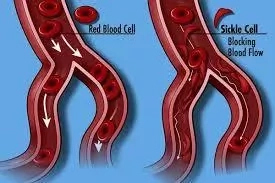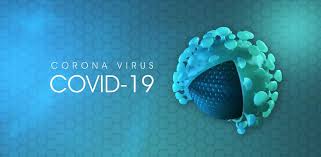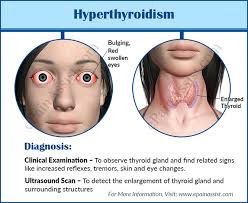Sickle cell anemia is one of a group of disorders known as sickle cell disease. Sickle cell anemia is an inherited red blood cell disorder in which there aren’t enough healthy red blood cells to carry oxygen throughout your body.
Normally, the flexible, round red blood cells move easily through blood vessels. In sickle cell anemia, the red blood is shaped like sickles or crescent moons.
Read Also: HOW DOES SLEEPING ADD ANY BENEFIT TO OUR HEALTH?

These rigid, sticky cells can get stuck in small blood vessels, which can slow or block blood flow and oxygen to parts of the body.
CAUSES
Sickle cell anemia is caused by a mutation in the gene that tells your body to make the iron-rich compound that makes blood red and enables red blood cells to carry oxygen from your lungs throughout your body (hemoglobin).
In sickle cell anemia, the abnormal hemoglobin causes red blood cells to become rigid, sticky, and misshapen.
Both mother and father must pass the defective form of the gene for a child to be affected.
Read Also: All about health
If only one parent passes the sickle cell gene to the child, that child will have the sickle cell trait. With one normal hemoglobin gene and one defective form of the gene, people with the sickle cell trait make both normal hemoglobin and sickle cell hemoglobin.
Their blood might contain some sickle cells, but they generally don’t have symptoms. They’re carriers of the disease, however, which means they can pass the gene to their children.
COMPLICATIONS
Sickle cell anemia can lead to a host of complications, including stroke. Sickle cells can block blood flow to an area of your brain.
Signs of a stroke include seizures, weakness or numbness of your arms and legs, sudden speech difficulties, and loss of consciousness. If your child has any of these signs and symptoms, seek medical treatment immediately. A stroke can be fatal.
Acute chest syndrome. A lung infection or sickle cells blocking blood vessels in your lungs can cause this life-threatening complication, resulting in chest pain, fever, and difficulty breathing. It might require emergency medical treatment.
Pulmonary hypertension. People with sickle cell anemia can develop high blood pressure in their lungs. This complication usually affects adults. Shortness of breath and fatigue are common symptoms of this condition, which can be fatal.
Organ damage. Sickle cells that block blood flow to organs deprive the affected organs of blood and oxygen. In sickle cell anemia, blood is also chronically low in oxygen.
Read Also: What are the health benefit of vegetables
This lack of oxygen-rich blood can damage nerves and organs, including your kidneys, liver, and spleen, and can be fatal.
Blindness. Sickle cells can block tiny blood vessels that supply your eyes. Over time, this can damage your eye and lead to blindness.
Leg ulcers. Sickle cell anemia can cause open sores on your legs.
Gallstones. The breakdown of red blood cells produces a substance called bilirubin. A high level of bilirubin in your body can lead to gallstones.
Priapism. In this condition, men with sickle cell anemia can have painful, long-lasting erections. Sickle cells can block the blood vessels in the penis, which can lead to impotence over time.
Pregnancy complications. Sickle cell anemia can increase the risk of high blood pressure and blood clots during
pregnancy. It can also increase the risk of miscarriage, premature birth, and having low birth weight babies.
SIGNS AND SYMPTOMS
Signs and symptoms of sickle cell anemia usually appear around 5 months of age. They vary from person to person and change over time. Signs and symptoms can include:
Anemia. Sickle cells break apart easily and die, leaving you with too few red blood cells. Red blood cells usually live for about 120 days before they need to be replaced. But sickle cells usually die in 10 to 20 days, leaving a shortage of red blood cells (anemia).
Without enough red blood cells, your body can’t get enough oxygen, causing fatigue.
Episodes of pain. Periodic episodes of pain, called pain crises, are a major symptom of sickle cell anemia.
Pain develops when sickle-shaped red blood cells block blood flow through tiny blood vessels to your chest, abdomen, and joints. Pain can also occur in your bones.
Read Also: Physical health education deals with what??
The pain varies in intensity and can last for a few hours to a few weeks. Some people have only a few pain crises a year. Others have a dozen or more pain crises a year. A severe pain crisis requires a hospital stay.
Some adolescents and adults with sickle cell anemia also have chronic pain, which can result from bone and joint damage, ulcers, and other causes.
Swelling of hands and feet. The swelling is caused by sickle-shaped red blood cells blocking blood flow to the hands and feet.
Frequent infections. Sickle cells can damage your spleen, leaving you more vulnerable to infections. Doctors commonly give infants and children with sickle cell anemia vaccinations and antibiotics to prevent potentially life-threatening infections, such as pneumonia.
Delayed growth or puberty. Red blood cells provide your body with the oxygen and nutrients needed for growth. A shortage of healthy red blood cells can slow growth in infants and children and delay puberty in teenagers.
Vision problems. Tiny blood vessels that supply your eyes can become plugged with sickle cells. This can damage the retina — the portion of the eye that processes visual images — and lead to vision problems.
DIAGNOSIS
Blood tests
Hemoglobin electrophoresis
Prenatal testing
Read Also: Do you think using cell phones too much is bad for our physical or mental health? Why?
TREATMENT
Preventing crises
Controlling the anemia
Relieving symptoms
Stem cell transplantation may cure sickle cell disease. Bone marrow or stem cells from a family member or other donor who does not have the sickle cell gene may be transplanted in a person with the disease.
Although such transplantation may be curative, it is risky and so it is not often done. Recipients must take drugs that suppress the immune system for the rest of their life.
Gene therapy, a technique in which normal genes are implanted in precursor cells (cells that produce blood cells), is being studied.





